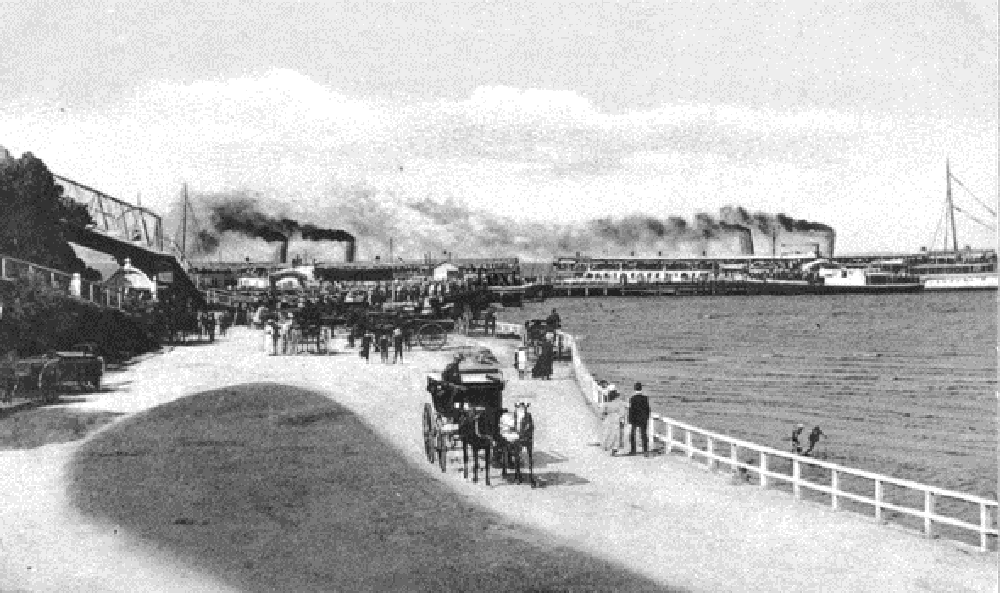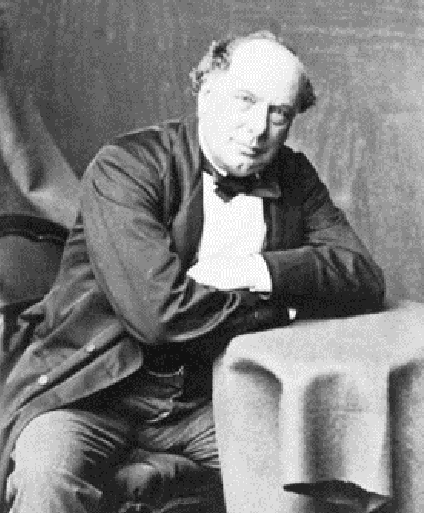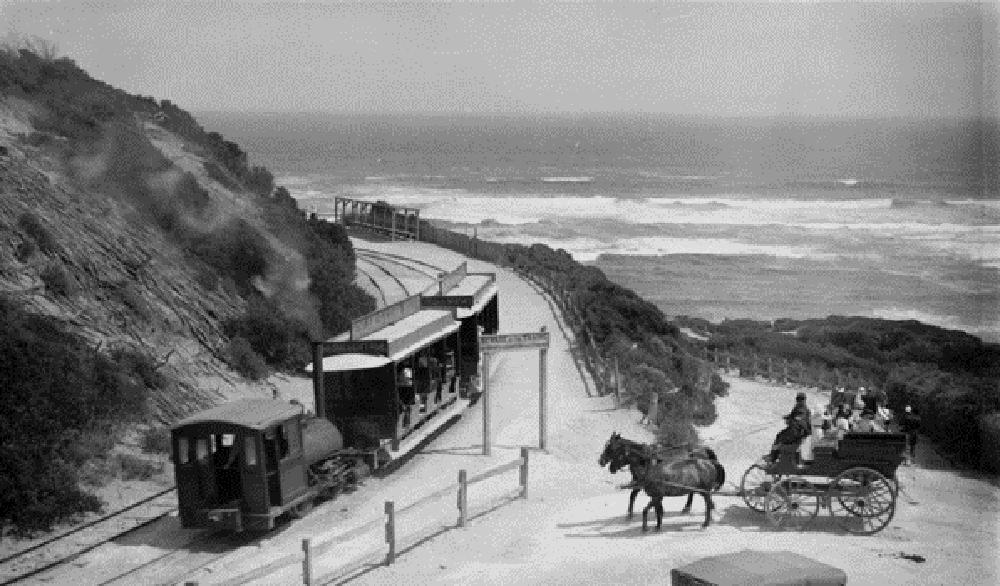By Lance Hodgins
In the late 1800s it was a very special outing to cross Port Phillip Bay to Sorrento by paddle steamer and take the tramway to the Ocean Beach. Over 50,000 would enjoy this experience each season, which lasted from early November to Easter. The paddle steamers Ozone and the Hygeia, both about 300 feet long, could transport passengers in comfort across the Bay in excess of twenty knots.
The Journey
At Sorrento, passengers disembarked and walked along the pier where they encountered waiting horse-drawn “cabs” – or they could take a footbridge to Tramway Hill where a waiting steam train was blowing its whistle. The return trip cost six pence (the equivalent of about $25 today) and, once boarded, it was a short haul up a hill to the Continental Hotel before turning right down the main shopping street on the one mile journey to the Ocean Beach Park.
Passing by huge guest houses, the steam locomotive and its carriages finally stopped on a curve high above the Back Beach and disgorged its passengers, who could take refreshments and promenade along the spectacular beach and coastline. After several hours, a warning whistle announced that it was time to return to the pier and catch the steamer home.

George Coppin

This brilliant tourist attraction lasted for thirty years, but it was not without its critics and it was plagued by constant controversy. Its creator, George Coppin, was controversial enough in himself. By the time he founded the tramway in 1889, he was already 70 years of age with a lifetime of achievements behind him.
Coppin was an astute, ruthless and imaginative entrepreneur. Often called the ‘Father of Australian Theatre’, he built six theatres and brought some great talent to this country. He developed an amusement park, imported the first white swans, provided camels to Burke and Wills, conducted the first hot air balloon ascent, and ran a roller skating rink. His interests included banking, mining and horseracing. He founded the Gordon House for the homeless and Victoria’s Royal Humane Society, and was the Mayor of Richmond and a Member of Parliament.
Coppin had grandiose plans for his beloved Sorrento, the location of his “holiday” home. Having pioneered steam excursions down the Bay since the 1870s, he formed a company which built the Continental Hotel, swimming baths, the Mechanics Institute, a guest house and several cottages – all at a time when there were only 22 houses in the district.
Coppin’s Ocean Amphitheatre Company recognised that Sorrento’s back beach was the jewel in the crown and he began to make improvements there. A road was cut through the high dune cliffs and four miles of paths constructed, along with a large rotunda to provide magnificent views of the coastline and the well-laid out parks of the natural bowl below.
Within a decade he was planning a novel way to reach it. In July 1889 the Sorrento Tramway Company was seeking 2,400 red gum sleepers and 150 cubic yards of limestone metal. During the first week of November, residents of Mornington reported seeing eleven splendid horses passing through their town hauling the first of two US-built Baldwin locomotives – each of which would pull up to four 50-passenger open cars.
By Christmas 1889, the tramway was in business.

Complaints roll in
It wasn’t long before the first complaint rolled in. In mid-January a tourist had travelled down on the Ozone and when she alighted at the back beach her dress caught fire from the “sparks which were flying around in all directions” and it was put out by fellow passengers. She later claimed that a hole 4 x 6 inches had been burnt through four layers of serge.
“I could have lost my life!” she exclaimed.
The conductor, Mr S W Clarke, was not aware of any commotion (which would have accompanied the accident) and the fact it was not reported for two hours cast some doubt on the veracity of her account.
It was not only the tourists who had concerns. In May 1990 a deputation of townsfolk asked the Minister of Lands to appoint more trustees to the Ocean Park to obtain a broader representation of the community. The local business men (including hoteliers) were upset at the tramway taking visitors past their establishments to be refreshed at the back beach for the day.
The response from the tramway company was that shares had been made available to every business man in town, as had the tender for the refreshment stall – the rent from which goes to improvements in the Park anyway. Furthermore, people do not have to take the tramway – they can freely elect to stay in the town and patronise the establishments there.
For the horse-drawn “cabbies’, competition was more direct and clashes were more frequent and long-lasting.
Before the tramway even opened, one cabman had caught his buggy wheel on the points of the line and smashed it to pieces.
George Wilby’s case was more serious and brought an appearance in court. In May 1892 the 72 year-old cab proprietor was driving back from Ocean Park when he “heard the tram whistle and had tried to clear the tracks as quickly as possible but was hit at about 15 mph”. He was thrown out of his cab and “severely injured his knee and suffered a shock to the system”. The conductor deposed that he had sounded the whistle and Wilby had actually turned onto the tracks where he was hit by the tram which had almost come to a halt. Wilby admitted that he was “a little merry on the day” and his demand for £25 costs was disallowed by the jury.
A couple of years later it was tram vs. tram in a mystifying accident. The two trams had a head-on collision on the Amphitheatre (Back Beach) Road right opposite the Mechanics Institute. No-one could explain why the two trams were travelling in the opposite direction on a single line when there were two tracks available. The passengers were jolted from their seats and one of them suffered severe internal injuries and several others were treated for cut and bruises. The Ozone’s departure was delayed for an hour for an incident which created bad press for the tramway.
The 1890s were particularly distressing times economically for businessmen and property owners. George Coppin survived these years largely due to a wise investment in Melbourne’s Theatre Royale. He held one-third of the tramway company shares and he continued to provide money to keep his pet project functioning.
In late 1902 it became public knowledge that the Sorrento Tramway Company might very well be put up for sale. The debenture holders held a full mortgage and bill of sale over all of the movable property for payment of £12,000 and seemed determined to sell everything a soon as possible.
But who would buy it? As one observer mildly put it: “With such an unkindly feeling as exists amongst the Sorrento people against the tramway, it seems that no one will purchase it with the intention of running it.” Others felt that once the tramway closed down the cabmen would have it all their own way and the increased dust and chaos would deny the Back Beach experience to many thousands of visitors.

The Cabbies Fire Up
The cabbies were spoiling for a fight and in February 1903 came the most serious challenge to date. Two cab drivers, E J Dark and R Hutcheson, lodged a formal complaint with Council about the state of the dust on the tracks and a collision which had ensued.
At the corner near the Back Beach Palace, the driver sounded his whistle as is customary and then saw Dark’s cab coming slowly down the line. The driver put on his brakes and the cabbie turned and stopped in the middle of the line and part of his wheel was knocked off. When Dark was asked if he had not heard the whistle, he replied that he had but didn’t know from which direction it was coming as there was so much dust in the air.
The driver in charge of the tram supported this version of events, and maintains that he was doing only about 2 mph when he hit the cabbie’s wheel. “It looked to me like a premeditated affair as he had no right to cross the track a second time,” said Mr Hulse. “I have had trouble with Dark on two occasions in the past and have had to avoid accidents with him both times. He is the only man to have given me any trouble.”
EJ Dark had a livery stable which had become insolvent in 1889. He was forced to sell off most of his wagonettes and fine harness horses just as the tramway was starting up. Nevertheless, he was not without credibility in the community: a member of the Sorrento Progressive League, a committeeman of the Sorrento Rifle Club and a founding trustee of the local ANA branch. He would go on to own “Ophir” – one of Sorrento’s finest boarding houses, ironically overlooking the tramway terminus.
The objections delivered to Council also raised the matter of the speed at which the trams were going. Councillors were concerned that, as the trams were laden with passengers, if the excessive speed was permitted to continue then the smash up would be a big one – and where would the Council be then? One councillor accused the trams of running at 20mph which was double their stipulated speed limit. The local constable would be asked to provide a report on the matter.
During this debate the tramway employees were incensed that Councillor Marsden had called them a ‘pack of liars’. George Porter had worked for the Sorrento Tramway Company for ten years and he pronounced that he “did not feel that George Coppin was in the habit of employing liars”.
The speed issue and some needed repairs prompted the councillors to make a tour of inspection of the tramway. This confirmed their impression that the tramway was being conducted in a very satisfactory manner – despite some comments to the contrary. They recognised that the tramway was a Shire asset: the Company should pay for the upkeep of the track and stick to its speed regulations, and the Shire should fix up some mullock caused largely by horse drawn carriages. The Company was given three months to make the necessary repairs.
By mid-1903 the ageing George Coppin was divesting himself of many of his assets. The Sorrento Tramway Company was under offer for purchase for a very low price (reputedly £600) and efforts were being made to form a local company to acquire the entire property and rolling stock. A public meeting resolved to buy it and there was a call for shares. Within weeks, however, the sale had fallen through and the Company was bought by a Melbourne syndicate headed up by Sorrento businessman, Isaac Bensilum, owner of the Continental Hotel.

His company spent a good deal of money on the property, installing new boilers in the engines and keeping the equipment generally in good order. For the next five years it ran on a sound financial basis, although it was constantly being brought to account by Council at the urging of the cabmen. The crossing at the Continental Hotel was frequently breaking axles and in May 1907 Councillors Clark and Marsden gave the Company three months to put its line in repair “otherwise it would be forfeited to the Shire”.
Feelings ran high as the Sorrento Cabmen’s Association formally objected to the Tramway Company operating without a licence and requested that Council lower their own fees from £1 to 10 shillings. Formalities were cast aside on one Saturday night in February 1908 when a quantity of brushwood was piled up under the tramway’s bridge leading to the pier, soaked with kerosene and lit. At 4 am the smoke and flames were spotted by an early morning fisherman who raised the alarm and prevented further damage.
The Council Has An About Face
In July 1913 the people of Sorrento woke to the news that their Council had renewed the Tramway Company’s contract for another 30 years – despite it still having seven years to run on the original deal. The Company would pay the council £20 for the first ten years, £25 for the second ten years and £30 in the final ten years.
This took everyone by surprise and upset many locals who felt they should have been consulted. To make a decision now for the next thirty years was ignoring “advances in electric traction and motor bus transport”.

Several well-attended public meetings concluded that “the action of the council was in direct antagonism to the interests of the district. The engines and trams are completely out of date, shabby and a discredit to Sorrento as one of the favourite watering places of the State.” A deputation to council asked that the resolution be rescinded and put before the ratepayers.
Council agreed to a stay of proceedings and sought legal advice. They rejected “those foul and slanderous accusations” that they had been promised investment money if they extended the tramway contract. They also denied having acted in secrecy, pointing out that the decision had been made in open council. Many councillors continued to believe that they were both legally and morally right to extend the contract, but there was serious disagreement in their ranks.
The Minister of Works gave the matter careful consideration and ultimately advised that the Shire should not have committed itself seven years in advance. In September 1913 Council rejected its own proposal to extend the Tramway Company’s lease and decided to wait out the original lease.
And so it was back to the petty bickering between the cabmen and the tram drivers. This time it was the excessive whistling of the trams, the drivers claiming that they were only trying to warn people in the face of the false accusations the cabbies were making. They couldn’t have it both ways: less whistling meant less warning and more danger on the tracks.
Yet no one had complained about whistling on the journey through town so attention focussed on the noise at the terminus. One councillor had counted 72 loud and long blasts from the station, but another reminded him that this was merely to attract business from the newly arrived steamer passengers – and also, admittedly, to annoy the cabmen. The Shire Secretary was instructed to write to each party and ask the tram driver to control his whistling and the cabmen to refrain from their constant shouting.
The End of the Tramway
When the original thirty year lease ran out in March 1920 the Company believed it had the right of renewal – which the Council denied.
The Loch Valley Timber Co had already offered £4,000 for the plant: two Baldwin locomotives, nine cars, one mile of double track of 60 lb steel rails and 4,000 sleepers. The package was offered to the Shire for the same amount of money but it was rejected. Council had obviously been swayed by a petition gathered by those who wanted to see visitors stay at the front beach.
There were some who had opposing views and for them it was a sad day when the old locomotives were hauled off to the forests of Noojee.

One observer remarked: “The tram had been immortalised on the picture post cards and in a hundred and one ways it had become almost a part of Sorrento itself. But now it is no more, owing to the short-sighted policy of Flinders Shire council.”
Over the following summer it was noted that “on an average day in past seasons the tram had carried 2,000 and now barely half that number make the trip to the Back Beach.
“The removal of the tram was one of the worst things that could have happened to Sorrento. The additional vehicular traffic in the main street of the town calls for a much larger expenditure by the council in repair work.
“The hill from the pier to the business portion of town is badly rutted and dangerous to motorised and horse drawn vehicles alike … Sorrento merits better treatment.”
The road to the Back Beach was in even worse condition. There was no longer a tramway and even the cabmen found it almost impassable.






